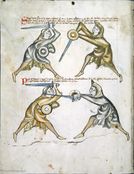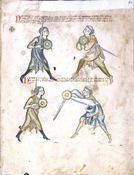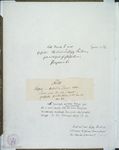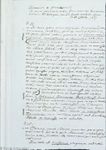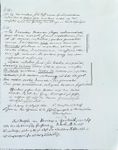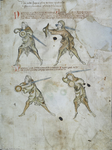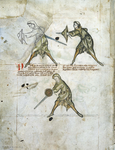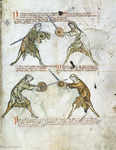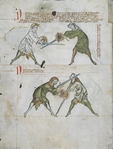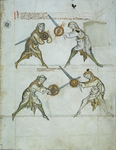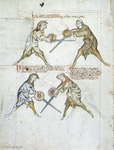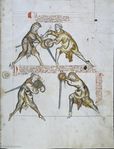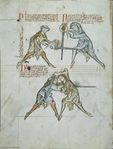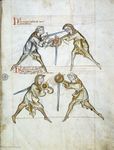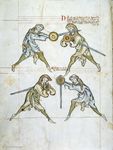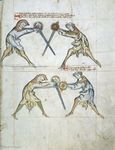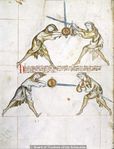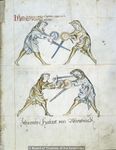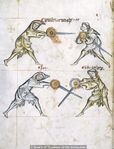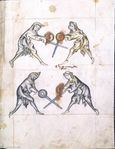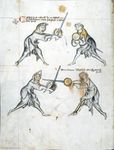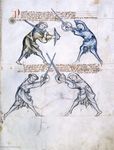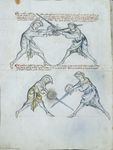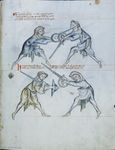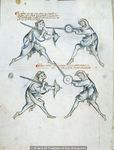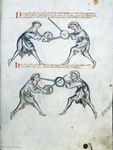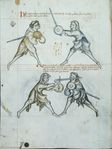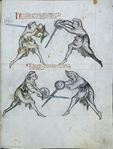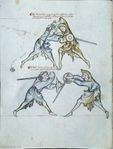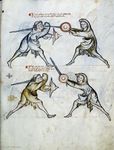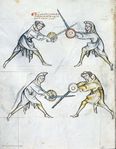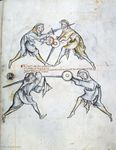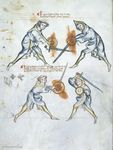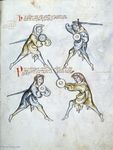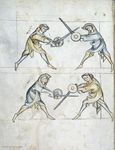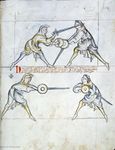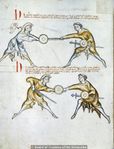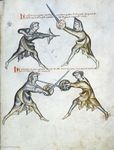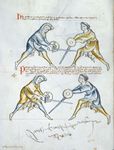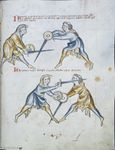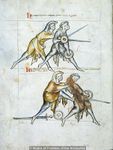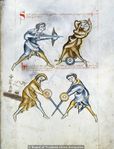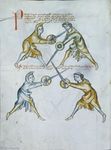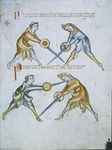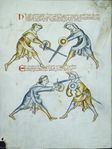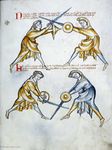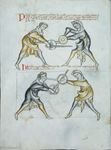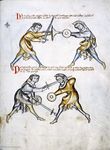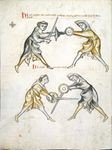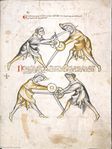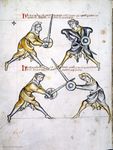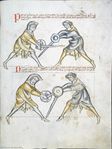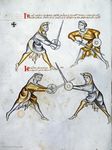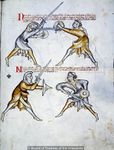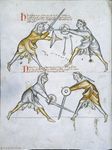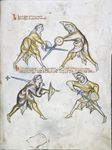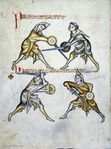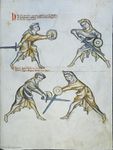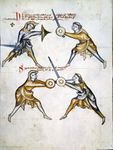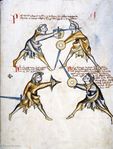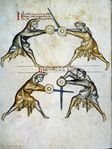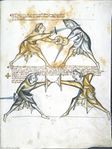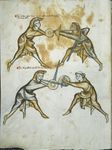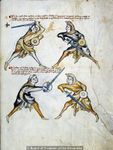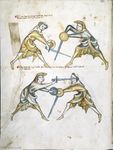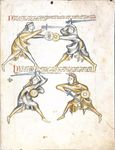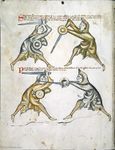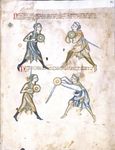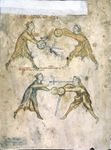|
|
| (89 intermediate revisions by 2 users not shown) |
| Line 2: |
Line 2: |
| | <!----------Name----------> | | <!----------Name----------> |
| | | name = [[name::Walpurgis Fechtbuch]] | | | name = [[name::Walpurgis Fechtbuch]] |
| − | | location = [[inventory::MS I.33]], [[museum::Royal Armouries]]<br/>Leeds, United Kingdom | + | | location = {{#set: inventory = MS Ⅰ.33}}, [[museum::Royal Armouries]]<br/>Leeds, United Kingdom |
| | <!----------Image----------> | | <!----------Image----------> |
| | | imageleft = File:MS I.33 31v.jpg | | | imageleft = File:MS I.33 31v.jpg |
| | | imageright = File:MS I.33 32r.jpg | | | imageright = File:MS I.33 32r.jpg |
| − | | width = x165px | + | | width = x175px |
| | | caption = ff 31v-32r, including St. Walpurga in her ward | | | caption = ff 31v-32r, including St. Walpurga in her ward |
| | + | | keyimage = File:MS I.33 32r.jpg |
| | <!----------General----------> | | <!----------General----------> |
| − | | Index number = [[WI::—]] | + | | Hagedorn's catalog = [[HS::LF]] |
| | | Wierschin's catalog= [[WC::09|9]] | | | Wierschin's catalog= [[WC::09|9]] |
| | | Hils' catalog = [[HK::30]] | | | Hils' catalog = [[HK::30]] |
| − | | Beck catalog = [[BC::38.9.8]] | + | | Beck catalog = [http://kdih.badw.de/datenbank/handschrift/38/9/8 38.9.8] {{#set:BC=38.9.8}} |
| − | | Also known as = {{plainlist | ''Liber de Arte Dimicatoria'' | "The Tower Manuscript" | No. 14 E iii, No. 20 }} | + | | Also known as = {{plainlist |
| | + | | ''[[title::Liber de Arte Dimicatoria]]'' |
| | + | | "The Tower Fechtbuch" |
| | + | | No.14.E.ⅲ; No.20 |
| | + | | FECHT 1 |
| | + | }} |
| | | Type = [[type::Fencing manual]] | | | Type = [[type::Fencing manual]] |
| | | Date = ca. [[year::1320s]] | | | Date = ca. [[year::1320s]] |
| Line 19: |
Line 25: |
| | | Language(s) = [[language::Medieval Latin]] | | | Language(s) = [[language::Medieval Latin]] |
| | | Scribe(s) = Unknown (three hands) | | | Scribe(s) = Unknown (three hands) |
| − | | Ascribed to = Clerus Lutegerus{{#set:author=Lutegerus}} | + | | Ascribed to = Clericus Lutegerus |
| | | Compiled by = | | | Compiled by = |
| | | Illuminated by = Unknown (up to 17 artists) | | | Illuminated by = Unknown (up to 17 artists) |
| Line 25: |
Line 31: |
| | | Dedicated to = | | | Dedicated to = |
| | <!----------Form and content----------> | | <!----------Form and content----------> |
| − | | Material = Parchment, in a modern <br/>binding | + | | Material = Parchment, in a modern binding |
| − | | Size = 34 [[folia]] | + | | Size = 32 [[folia]] (230 mm × 300 mm) |
| − | | Format = Double-sided; two illustrations <br/>per side with text above and <br/>below | + | | Format = Double-sided; two illustrations per side <br/>with text above and below |
| | | Condition = | | | Condition = |
| − | | Script = [[script::Bastarda]] | + | | Script = |
| | | Contents = | | | Contents = |
| | | Illumination(s) = | | | Illumination(s) = |
| | | Additions = | | | Additions = |
| | | Exemplar(s) = | | | Exemplar(s) = |
| − | | Previously kept = MS Membr.I 115, <br/>[[Forschungsbibliothek Gotha|Schloß Friedenstein]] | + | | Previously kept = MS Membr.I 115,<br/>[[Forschungsbibliothek Gotha|Schloß Friedenstein]] |
| | | Discovered = | | | Discovered = |
| − | | Website = | + | | Website = [https://collections.royalarmouries.org/archive/rac-archive-391002.html Museum catalog entry] |
| − | | Images = {{plainlist | [http://commons.wikimedia.org/wiki/Category:Royal_Armouries_Ms._I.33 Digital scans] (600x800) | [http://www.thearma.org/Manuals/i33/i33.htm Microfilm scans] }} | + | | Images = {{collapsible list |
| − | | Translations = {{plainlist | {{german translation|http://schwertfechten.ch/html/i33/|1}} | {{italian translation|http://lutegerus.wordpress.com/|1}} | {{italian translation|http://www.compaquila.com/manuali/I-33.pdf|1}} }} | + | | [[Media:Royal Armouries Ms. I.33 - ca. 1320s - OGL v3.0.pdf|Digital scans]] (1500x2000) |
| | + | | [http://commons.wikimedia.org/wiki/Category:Royal_Armouries_Ms._I.33 Digital scans] (600x800) |
| | + | | [http://www.thearma.org/Manuals/i33/i33.htm Microfilm scans] |
| | + | }} |
| | + | | Translations = |
| | | below = | | | below = |
| | }} | | }} |
| − | {{ambox | text = Unfortunately, the [[Royal Armouries]]' [http://collections.royalarmouries.org/index.php image hosting servers] have been down for well over a year now, and the projected date for restoration of service has been pushed back many times; the [http://royalarmouries.org/collections collections page] currently lists an estimate of the end of 2014. If you need to view the MS I.33 images in the interim, they are mirrored on [[commons:Category:Royal Armouries Ms. I.33|WikiMedia Commons]]. }}
| + | '''MS Ⅰ.33''' (pronounced "one thirty-three", sometimes called the Walpurgis ''Fechtbuch'', the Lutegerus ''Fechtbuch'', or the Tower ''Fechtbuch'') is a [[nationality::German]] [[fencing manual]] dating to the 1320s.<ref>The manuscript has received a wide variety of dates. Anglo (1988) dated it to "the very end of the 13th century" and Hils (1985) to the early 14th century; Cinato and Surprenant (2009) are even less precise, placing it at around the turn of the 14th century. Most recent analysis has preferred the very late end of this range, with Leng (2008) dating it to 1320-1330 and Hester (2012) to "around 1320".</ref> It currently rests in the holdings of the [[Royal Armouries]] at Leeds, United Kingdom. It contains oldest extant treatise on Medieval martial arts, ''[[Liber de Arte Dimicatoria]]'', and it appears to have been devised by a secular priest, possibly the "Lutegerus" (Ludger) mentioned in the text.<ref>See [[page:Ms I33 fol 01v.jpg|folio 1v]].</ref> It was the work of three scribes and potentially as many as 17 illustrators.<ref name="Hester">Hester (2012).</ref> The manuscript in its present form consists of five quires, of which all but the first are incomplete; at least eight leaves are believed to be missing (assuming it started with complete quires of four bifolia each).<ref name="Hester"/> |
| − | The '''MS I.33''' is a [[nationality::German]] [[fencing manual]] dating to the 1320s.<ref>The manuscript has received a wide variety of dates. Anglo (1988) dated it to "the very end of the 13th century" and Hils (1985) to the early 14th century; Cinato and Surprenant (2009) are even less precise, placing it at around the turn of the 14th century. Most recent analysis has suggested a slightly later date, with Leng (2008) dating it to 1320-1330 and Hester (2012) to "around 1320".</ref> It currently rests in the holdings of the [[Royal Armouries]] at Leeds, United Kingdom. The I.33 is earliest extant treatise on Medieval martial arts, and it appears to have been devised by a secular priest, possibly the "Lutegerus" (or Liutger) mentioned in the text.<ref>See [[page:Ms I33 fol 01v.jpg|folio 1v]].</ref> It was the work of three scribes and potentially as many as 17 illustrators.<ref name="Hester">Hester (2012).</ref>
| |
| − | | |
| − | The treatise is fully illustrated, and consists of both mnemonic verses and longer explanations in a vernacular Medieval Latin. (The format of verse and gloss may indicate that the priest was explaining a much older tradition.) It treats unarmored fencing with [[arming sword|sword]] and [[buckler]]; the intriguing fact that the fencers depicted are a priest and a student (and on the last two pages, a priest and a woman identified as St. Walpurga), seems to suggest that this was a middle class or priestly art rather than one of the knightly class. Repeatedly, the text makes mention of the pupils (''scolaris/discipulus'') of the priest, as well as youths (''iuvenis'') and clients (''clientulum''). It seems, therefore, to have been prepared for secular priests who were offering fencing lessons to young men.
| |
| − | | |
| − | The manuscript in its present form consists of five quires, of which all but the first are incomplete; at least eight leaves are believed to be missing (assuming it started with complete quires of four bifolia each).<ref name="Hester"/> The precise contents of these missing leaves are unknown, but it is possible that they were a source for the thirty [[Anonymous Sword and Buckler Images|uncaptioned sword and buckler plays]] which appear in the [[Berlin Sketchbook (Libr.Pict.A.83)|Libri Picture A 83]], the [[Jörg Breu Draftbook (Cod.I.6.2º.4)|Codex I.6.2º.4]], and the [[Lienhart Sollinger Fechtbuch (Cgm 3712)|Cgm 3712]]; alternatively, these may originate from another manuscript in the same tradition. The anonymous plays seem in turn to have been the primary source for [[Paulus Hector Mair]]'s treatment of the [[side sword]] and buckler, which he captioned with his own interpretations. | |
| | | | |
| | == Provenance == | | == Provenance == |
| | | | |
| − | The known provenance of the MS I.33 is: | + | The known provenance of MS Ⅰ.33 is: |
| | | | |
| − | * Written in the 1320s, possibly by a priest named Liutger; owned by Franconian monks until the 1500s. | + | * Written in the 1320s, possibly by a priest named Ludger; owned by Franconian monks until the 1500s. |
| − | * 1400s – an additional couplet was inscribed at the top of [[:File:MS I.33 01r.jpg|folio 1r]], possibly by Enea Silvio Piccolomini (Pope Pius II; 1405-1464).{{cn}} | + | * 1400s – an additional couplet was inscribed at the top of [[:File:MS I.33 01r.jpg|folio 1r]], apparently a quotation from Enea Silvio Bartolomeo Piccolomini (Pope Pius Ⅱ). |
| − | * 1552-53 – looted from a monastery by [[Johannes Herbart von Würzburg]] during the Franconian campaigns of Albert-Archibald, Duke of Brandenburg-Kulmbach.<ref name="Gunterrodt">[[Heinrich von Gunterrodt|von Gunterrodt, Heinrich]]. ''[[De Veris Principiis Artis Dimicatorie (Heinrich von Gunterrodt)|De Veris Principiis Artis Dimicatorie]]''. Wittenberg, 1579. p C3rv</ref><ref name="Hester"/> Würzburg was a belt-maker by trade and later served as [[fencing master]] to the dukes of Sachsen-Gotha; he inscribed his name on [[:File:MS I.33 07r.jpg|folio 7r]]. | + | * 1552-53 – looted from a monastery by [[Johannes Herbart von Würzburg]] during the Franconian campaigns of Albrecht Ⅱ, margrave of Brandenburg-Kulmbach.<ref name="Gunterrodt">[[Heinrich von Gunterrodt|von Gunterrodt, Heinrich]]. ''[[De Veris Principiis Artis Dimicatorie (Heinrich von Gunterrodt)|De Veris Principiis Artis Dimicatorie]]''. Wittenberg, 1579. p C3rv</ref><ref name="Hester"/> Würzburg was a belt-maker by trade and later served as [[fencing master]] to the dukes of Sachsen-Gotha; he inscribed his name on [[:File:MS I.33 07r.jpg|folio 7r]]. |
| | * before 1579 – possibly duplicated by [[Heinrich von Gunterrodt]] while compiling material for his book<ref name="Gunterrodt"/> (such a copy is currently unknown). | | * before 1579 – possibly duplicated by [[Heinrich von Gunterrodt]] while compiling material for his book<ref name="Gunterrodt"/> (such a copy is currently unknown). |
| − | * late 1500s-1945 – owned by the dukes of Sachsen-Gotha; listed in an 18th century library catalog as Cod.Membr.I.no.115.{{cn}} The second device on [[:File:MS I.33 26r.jpg|folio 26r]] was copied into the [[Talhoffer Fechtbuch (Cod.Guelf.125.16.Extrav.)|Codex Guelf 125.16 Extravagante]] in the 1600s by a scribe who couldn't decipher the Latin text.<ref>See [[:File:Cod.Guelf.125.16.Extrav. 45r.jpg|Codex Guelf 125.16.Extrav f 45r]].</ref> The manuscript was further described on six leaves of paper (with short excerpts of the text) by Heinrich Niewöhner in 1910. (Lost during World War II.) | + | * late 1500s-1945 – owned by the dukes of Sachsen-Gotha; listed in an 18th century library catalog as Cod.Membr.Ⅰ.no.115.{{cn}} The second piece on [[:File:MS I.33 26r.jpg|folio 26r]] was copied into the [[Talhoffer Fechtbuch (Cod.Guelf.125.16.Extrav.)|Cod.Guelf.125.16.Extrav.]] (<small>HTWo</small>) in the 1600s by a scribe who couldn't decipher the Latin text.<ref>See [[Page:Cod.Guelf.125.16.Extrav. 45r.jpg|Cod.Guelf.125.16.Extrav., f 45r]].</ref> The manuscript was further described on six leaves of paper (with short excerpts of the text) by Heinrich Niewöhner in 1910. (Lost during World War Ⅱ.) |
| − | * 1945-1950 – location unknown (sold London, [[Sotheby's]], 27 March 1950). Sotheby's listed the manuscript as "a 14th-century manuscript of unknown provenance", and it was not identified as the lost Cod.Membr.I.no.115. until Krämer in 1975.<ref>S. Krämer. "Verbleib unbekannt Angeblich verschollene und wiederaufgetauchte Handschriften." ''Zeitschrift für Deutsches Altertum und Deutsche Literatur,'' volume 104. 1975</ref> | + | * 1945-1950 – location unknown (sold London, [[Sotheby's]], 27 March 1950). Sotheby's listed the manuscript as "a 14th-century manuscript of unknown provenance", and it was not identified as the lost Cod.Membr.Ⅰ.no.115. until Krämer in 1975.<ref>S. Krämer. "Verbleib unbekannt Angeblich verschollene und wiederaufgetauchte Handschriften." ''Zeitschrift für Deutsches Altertum und Deutsche Literatur,'' volume 104. 1975</ref> |
| − | * 1950-1996 – held by the Royal Armouries and stored in the Tower of London; known variously as "Tower of London Ms. I.33" or "British Museum No. 14 E iii, No. 20, D. vi. I". | + | * 1950-1996 – held by the Royal Armouries and stored in the Tower of London; known variously as "Tower of London Ms. Ⅰ.33" or "British Museum No. 14 E ⅲ, No. 20, D. ⅵ. Ⅰ". |
| | * 1996 – moved to the newly-opened Royal Armouries Museum in Leeds. | | * 1996 – moved to the newly-opened Royal Armouries Museum in Leeds. |
| | | | |
| Line 65: |
Line 70: |
| | {| class="treatise" | | {| class="treatise" |
| | |- | | |- |
| − | ! id="page" | 1r - 32v | + | ! id="page" | Ⅰrv |
| − | | {{treatise begin | + | | Front matter |
| − | | title = [[Sword and buckler]], possibly by Liutger
| |
| − | | width = 76em
| |
| − | }}
| |
| − | {| class="wikitable floated master"
| |
| − | |-
| |
| − | ! id="thin" | <p>Images</p>
| |
| − | ! <p>{{rating|B}}<br/>by [[Dieter Bachmann]]</p>
| |
| − | ! <p>Transcription{{edit index|Walpurgis Fechtbuch (MS I.33)}}<br/>by [[Dieter Bachmann]]</p>
| |
| | | | |
| | |- | | |- |
| − | | rowspan="4" | [[File:MS I.33 1r.jpg|200px|center|Folio 1r]]
| + | ! [[Liber de Arte Dimicatoria|1r - 32v]] |
| − | | <p>'''[1]''' <em>Stygian Pluto dares not attempt, what dare<br/>the mindless monk, and the deceitful old woman.</em><ref>The introductory verse was added on the upper margin of the page. According to [Forgeng], it is attributed to Aenas Sylvius (later pope Pius II; 1405-64). It is obviously referring to other sorts of unmonkish behaviour, but it seems to underline the unusual nature of fencing monks and women.</ref></p> | + | | Sword and buckler, possibly by Clericus Lutegerus |
| − | | {{section|Page:Ms I33 fol 01r.jpg|1|lbl=1r}}
| |
| | | | |
| − | |- | + | |} |
| − | | <p>'''[2]''' It is to be noted, how in general all fencers, or all men holding a sword in hand, even if ignorant in the art of fencing, use these seven wards, of which we have seven verses:</p>
| |
| − | | {{section|Page:Ms I33 fol 01r.jpg|2|lbl=-}}
| |
| | | | |
| − | |-
| + | == Gallery == |
| − | | <p>'''[3]''' {{red|Seven wards there are, under the arm the foremost,<br/>to the right shoulder is given the second, to the left the third,<br/>to the head give the fourth, give to the right side the fifth,<br/>to the breast give the sixth, and finally have you the ''langort''.}}</p>
| |
| − | | {{section|Page:Ms I33 fol 01r.jpg|3|lbl=-}}
| |
| − | | |
| − | |-
| |
| − | | <p>'''[4]''' It is to be noted, that the art of fencing is so described: Fencing is the the ordering of diverse strikes, and is divided in seven parts, as here.</p>
| |
| − | | {{section|Page:Ms I33 fol 01r.jpg|4|lbl=-}}
| |
| − | | |
| − | |-
| |
| − | | rowspan="2" | [[File:MS I.33 1v.jpg|200px|center|Folio 1v]]
| |
| − | | <p>'''[5]''' Note, that the nucleus of all the art of fencing consists in this latter ward which is called ''langort''. Also, all actions of the wards or of the sword are determined by it, i.e. they end in it and not in others. Therefore, do first consider well this above-mentioned ward.</p>
| |
| − | | {{section|Page:Ms I33 fol 01v.jpg|1|lbl=1v}}
| |
| − | | |
| − | |-
| |
| − | | <p>'''[6]''' {{red|It is three that precede, the remaining do follow<br/>These seven parts are (also) executed by the common,<br/>(but) Brother Liutger<ref>''lutegerus:'' presumably the name of the author / ''sacerdos'': ''Liutger''.</ref> has the defense and the means.}}</p>
| |
| − | | {{section|Page:Ms I33 fol 01v.jpg|2|lbl=-}}
| |
| − | | |
| − | |-
| |
| − | | rowspan="4" | [[File:MS I.33 2r.jpg|200px|center|Folio 2r]]
| |
| − | | <p>'''[7] (+)''' It is to be seen that here is the first ward contained, i.e. the one under the arm, and the displacer is in ''halpschilt''. I give the good counsel that the one (assuming the ward) under the arm do not execute a strike, which is commendable from the ''albersleiben'', for the reason that he could not reach the upper part, and (reaching anywhere) lower would be pernicious to the head. But the displacer entering to attack may reach him at any time if he fails to observe what is written below:</p>
| |
| − | | {{section|Page:Ms I33 fol 02r.jpg|1|lbl=2r}}
| |
| − | | |
| − | |-
| |
| − | | <p>'''[8]''' Verse:<br/>{{red|The first ward / Has two counters,<br/>The first counter being ''halbschilt'', / The second ''Langort''.}}</p>
| |
| − | | |
| − | {{red|If ''Halbschild'' is adopted, fall / Below both sword and shield.<br/>If he is a common fencer, he will strike to the head, / Then you should apply ''stichschlach'',<br/>If he binds and enters, / Then you should counter with ''schiltschlac''.}}
| |
| − | | {{section|Page:Ms I33 fol 02r.jpg|2|lbl=-}}
| |
| − | | |
| − | {{section|Page:Ms I33 fol 02r.jpg|3|lbl=-}}
| |
| − | | |
| − | |-
| |
| − | | <p>'''[9]''' It is to be seen that the one who is higher is directing a strike to the head, without ''schiltslac'', if he is a common fencer. But if you would be instructed by the priest's counsel, do bind and enter.</p>
| |
| − | | {{section|Page:Ms I33 fol 02r.jpg|4|lbl=-}}
| |
| − | | |
| − | |-
| |
| − | | <p>'''[10]''' Note that the first ward, i.e. the one under the arm, may be displaced by itself, namely, the displacer may displace the one assuming the first ward with that selfsame ward. Nevertheless, the one assuming first ward can displace the displacer with a displacement that in a way corresponds to the displacement called ''halpschilt'', but differs from it in this, that the sword below the arm is extended above the shield, so that the hand holding the shield is enclosed by the hand holding the sword.</p>
| |
| − | | {{section|Page:Ms I33 fol 02r.jpg|5|lbl=-}}
| |
| − | | |
| − | |-
| |
| − | | rowspan="6" | [[File:MS I.33 2v.jpg|200px|center]]
| |
| − | | <p>'''[11]''' It is to be seen, that the pupil is here binding and entering, so that he may place a ''schiltschlac'', as below. But he should take heed of what is done by the priest, as after the bind the priest will be the first to act.</p>
| |
| − | | {{section|Page:Ms I33 fol 02v.jpg|1|lbl=2v}}
| |
| − | | |
| − | |-
| |
| − | | <p>'''[12]''' It is to be seen, that the pupil has no option but to do a ''schiltslac'', or to grip the arms of the priest with his left hand, namely sword and shield.</p>
| |
| − | | {{section|Page:Ms I33 fol 02v.jpg|2|lbl=-}}
| |
| − | | |
| − | |-
| |
| − | | <p>'''[13]''' Verse:<br/>{{red|Here the pupil binds and enters, for him is a ''schiltslac''<br/>Or with the left hand he grip the arms of the priest.}}</p>
| |
| − | | {{section|Page:Ms I33 fol 02v.jpg|3|lbl=-}}
| |
| − | | |
| − | |-
| |
| − | | <p>'''[14]''' The priest, on the other hand, has three options, namely mutation of the sword, so that it be higher, or ''durchtreten'', or with the {{dec|s|left}}<sup>right</sup> hand grasp the pupil's arms, i.e. sword and shield.</p>
| |
| − | | {{section|Page:Ms I33 fol 02v.jpg|4|lbl=-}}
| |
| − | | |
| − | |-
| |
| − | | <p>'''[15]''' {{red|These three are for the priest: ''durchtritt'', mutation of the sword,<br/>or with the right hand he may grasp sword and shield.}}</p>
| |
| − | | {{section|Page:Ms I33 fol 02v.jpg|5|lbl=-}}
| |
| − | | |
| − | |-
| |
| − | | <p>'''[16]''' Note that you find here what was said above, executed in the example.</p>
| |
| − | | {{section|Page:Ms I33 fol 02v.jpg|6|lbl=-}}
| |
| − | | |
| − | |-
| |
| − | | rowspan="2" | [[File:MS I.33 3r.jpg|200px|center]]
| |
| − | | <p>'''[17] (+)''' It is to be seen how the first ward is again assumed, because of certain actions of this first section, i.e. because of the first ward that was treated first. But all things that belong here you will find on the first page, up to the mutation of the sword.</p>
| |
| − | | {{section|Page:Ms I33 fol 03r.jpg|1|lbl=3r}}
| |
| − | | |
| − | |-
| |
| − | | <p>'''[18]''' {{red|If ''halbschilt'' is assumed, fall<br/>below both sword and shield.}}<ref>This verse is open to disputation. Most likely, ''quoque'' combines sword and shield into a unity; ''sub'' seems to refer to a lower bind, as ''halpschilt'' threatens a blow from above. The same situation is depicted 8v and 23v. That a binding between sword and shield is not intended becomes clear on fol. 11r, where exactly that move is deprecated.</ref></p>
| |
| − | | {{section|Page:Ms I33 fol 03r.jpg|2|lbl=-}}
| |
| − | | |
| − | |-
| |
| − | | rowspan="4" | [[File:MS I.33 3v.jpg|200px|center]]
| |
| − | | <p>'''[19]''' Here is a binding of the pupil's, and all other things, of which was talked above, until the mutation of the sword.</p>
| |
| − | | {{section|Page:Ms I33 fol 03v.jpg|1|lbl=3v}}
| |
| − | | |
| − | |-
| |
| − | | <p>'''[20]''' Here the pupil is wanting good counsel how he could withstand this, and you must know, that if the game stands as here, then a ''stich'' must be executed, as commonly contained in the book, even if here is no image.</p>
| |
| − | | {{section|Page:Ms I33 fol 03v.jpg|2|lbl=-}}
| |
| − | | |
| − | |-
| |
| − | | <p>'''[21]''' It is to be seen, that the priest is here mutating the sword, because he was below earlier, now he will be above. Then, he moves the free sword upwards, which is called ''nucken'', whence follows a separation of sword and shield of the pupil's.</p>
| |
| − | | {{section|Page:Ms I33 fol 03v.jpg|3|lbl=-}}
| |
| − | | |
| − | |-
| |
| − | | <p>'''[22]''' Thence the verse:<br/>{{red|Such is the monk's ''nucken'',<br/>where most of the common will ''schutzen''.}}</p>
| |
| − | | {{section|Page:Ms I33 fol 03v.jpg|4|lbl=-}}
| |
| − | | |
| − | |-
| |
| − | | rowspan="3" | [[File:MS I.33 4r.jpg|200px|center]]
| |
| − | | <p>'''[23]''' Here the priest should pay attention that he tarry not one instant with the sword, lest from that instant arise an act which is called grappling, but he must immediately re-establish the binding out of caution.</p>
| |
| − | | {{section|Page:Ms I33 fol 04r.jpg|1|lbl=4r}}
| |
| − | | |
| − | |-
| |
| − | | <p>'''[24] (+)''' {{red|H}}ere the first ward is re-assumed, to which ward the displacement will be very rare, because none uses to apply it save the priest or his clients, i.e. his students, and this displacement is called ''krucke'', and I counsel in good faith that the one executing the ward should bind immediately after the displacement, because it is not good to tarry, or that he should do aught by which he may be saved, or that he should immediately do that, which his displacer does.</p>
| |
| − | | {{section|Page:Ms I33 fol 04r.jpg|2|lbl=-}}
| |
| − | | |
| − | |-
| |
| − | | <p>'''[25]''' You must know that the displacer must not hesitate, but he should execute immediately a ''stich'' towards the displacer, so that his adversary cannot deliberate what he intend, and that should diligently comprehended.<ref>''diligenter intell...'': seems unclear to me; either the instructions, that one should not hesitate should be understood diligently, or the diligence with which the adversary will judge one's actions is stressed.</ref></p>
| |
| − | | {{section|Page:Ms I33 fol 04r.jpg|3|lbl=-}}
| |
| − | | |
| − | |-
| |
| − | | rowspan="4" | [[File:MS I.33 4v.jpg|200px|center]]
| |
| − | | <p>'''[26]''' Here the priest binds above the pupil's displacement, and immediately, all the preceding things which you had above; granted, you did not have the other two images which follow, where he grasps sword and shield.</p>
| |
| − | | {{section|Page:Ms I33 fol 04v.jpg|1|lbl=4v}}
| |
| − | | |
| − | |-
| |
| − | | <p>'''[27]''' Note that whenever binder and bound are competing as here, then the bound may flee whither he chooses, if he likes, and this is required in all bindings. But of this you must be admonished, that where ever the bound (flees to), you should follow him.</p>
| |
| − | | {{section|Page:Ms I33 fol 04v.jpg|2|lbl=-}}
| |
| − | | |
| − | |-
| |
| − | | <p>'''[28]''' {{red|Binder and bound<ref>''ligans ligati'': One would expect ''*ligans ligatusque'' vel. sim. (plural subject). Literally, the translation would be "The binder of the bound - they are...", or "The binder; the bound ones are...". But I believe my translation correctly renders the intended meaning.</ref> are adverse and irate;<br/>The bound flees to the side,<ref>''fugit ad partes laterum'': refers to side-stepping, i.e. taking into account the 3rd dimension not rendered in the images.</ref> I try to follow.}}</p>
| |
| − | | {{section|Page:Ms I33 fol 04v.jpg|3|lbl=-}}
| |
| − | | |
| − | |-
| |
| − | | <p>'''[29]''' Here the priest teaches his pupil, how from these above things he may grasp sword and shield. And you must know, that the priest cannot free himself from such a grip without the loss of sword and shield.</p>
| |
| − | | {{section|Page:Ms I33 fol 04v.jpg|4|lbl=-}}
| |
| − | | |
| − | |-
| |
| − | | rowspan="2" | [[File:MS I.33 5r.jpg|200px|center]]
| |
| − | | <p>'''[30]''' Here the priest defends against what the pupil did above.</p>
| |
| − | | {{section|Page:Ms I33 fol 05r.jpg|1|lbl=5r}}
| |
| − | | |
| − | |-
| |
| − | | <p>'''[31] (+)''' Here the first ward is re-assumed, but all that is necessary you have here in it, except only the omission of the binding, which the pupil omits.</p>
| |
| − | | {{section|Page:Ms I33 fol 05r.jpg|2|lbl=-}}
| |
| − | | |
| − | |-
| |
| − | | rowspan="2" | [[File:MS I.33 5v.jpg|200px|center|Folio 5v]]
| |
| − | | <p>'''[32]''' Here the pupil has neglected to bind, and the priest has promptly entered, and not undeservedly, as whenever the one assuming the ward omits something he should do, the displacer must immediately enter, as here.</p>
| |
| − | | {{section|Page:Ms I33 fol 05v.jpg|1|lbl=5v}}
| |
| − | | |
| − | |-
| |
| − | | <p>'''[33] (+)''' Displacement as before, but the game is varied.</p>
| |
| − | | {{section|Page:Ms I33 fol 05v.jpg|2|lbl=-}}
| |
| − | | |
| − | |-
| |
| − | | rowspan="2" | [[File:MS I.33 6r.jpg|200px|center|Folio 6r]]
| |
| − | | <p>'''[34]''' Above, the priest displaced the pupil. Here now, the pupil is executing the same action as the priest before. But the displacer should enter first, if the pupil omits it, as below. Also, he should take care that the other reach not his head, which he may.</p>
| |
| − | | {{section|Page:Ms I33 fol 06r.jpg|1|lbl=6r}}
| |
| − | | |
| − | |-
| |
| − | | <p>'''[35]''' And from the above actions, the priest enters, I have said: he should therefore mind his head.</p>
| |
| − | | {{section|Page:Ms I33 fol 06r.jpg|2|lbl=-}}
| |
| − | | |
| − | |-
| |
| − | | rowspan="2" | [[File:MS I.33 6v.jpg|200px|center|Folio 6v]]
| |
| − | | <p>'''[36] (+)''' Here the first ward is re-assumed, namely the one under the arm, which is displaced with a certain counter that is called ''langort'', and it is a common displacement, and the counters to this displacement are, for the part of the one assuming the ward, bindings above and below,</p>
| |
| − | | {{section|Page:Ms I33 fol 06v.jpg|1|lbl=6v}}
| |
| − | | |
| − | |-
| |
| − | | <p>'''[37]''' Whence the verse:</p>
| |
| − | | |
| − | <p>{{red|When langort is executed, do bind immediately, above or else below.<br/>But the higher binding is always more useful than the lower one.}}</p>
| |
| − | | {{section|Page:Ms I33 fol 06v.jpg|2|lbl=-}}
| |
| − | | |
| − | |-
| |
| − | | rowspan="3" | [[File:MS I.33 7r.jpg|200px|center|Folio 7r]]
| |
| − | | <p>'''[38]''' Here the game of the former ward will take place, namely of binder and bound,</p>
| |
| − | | {{section|Page:Ms I33 fol 07r.jpg|1|lbl=7r}}
| |
| − | | |
| − | |-
| |
| − | | <p>'''[39]''' Whence the verse:</p>
| |
| − | | |
| − | <p>{{red|Binder and bound are adverse and irate;<br/>The bound flees to the side, I try to follow.}}</p>
| |
| − | | {{section|Page:Ms I33 fol 07r.jpg|2|lbl=-}}
| |
| − | | |
| − | |-
| |
| − | | <p>'''[40] Johannes Herwart of Würzburg'''.</p>
| |
| − | | {{section|Page:Ms I33 fol 07r.jpg|3|lbl=-}}
| |
| − | | |
| − | |-
| |
| − | | rowspan="2" | [[File:MS I.33 7v.jpg|200px|center|Folio 7v]]
| |
| − | | <p>'''[41] (+)''' First ward and common displacement as above, but the game varies at the end of the passage.</p>
| |
| − | | {{section|Page:Ms I33 fol 07v.jpg|1|lbl=7v}}
| |
| − | | |
| − | |-
| |
| − | | <p>'''[42]''' Above</p>
| |
| − | :Below. But the priest has bound, in spite of being below.
| |
| − | | {{section|Page:Ms I33 fol 07v.jpg|2|lbl=-}}
| |
| − | | |
| − | :{{section|Page:Ms I33 fol 07v.jpg|3|lbl=-|p=1}}
| |
| − | | |
| − | |-
| |
| − | | [[File:MS I.33 8r.jpg|200px|center|Folio 8r]]
| |
| − | | <p>'''[43]''' Here a mutation of the sword below is taking place.</p>
| |
| − | | {{section|Page:Ms I33 fol 08r.jpg|1|lbl=8r}}
| |
| − | | |
| − | |-
| |
| − | | rowspan="2" | [[File:MS I.33 8v.jpg|200px|center|Folio 8v]]
| |
| − | | <p>'''[44] (+)''' The first ward is re-assumed and displaced by the first displacement, namely ''halpschilt'', and you will have all of the above.</p>
| |
| − | | {{section|Page:Ms I33 fol 08v.jpg|1|lbl=8v}}
| |
| − | | |
| − | |-
| |
| − | | <p>'''[45]''' Verse:</p>
| |
| − | | |
| − | <p>{{red|When ''halbschild'' is assumed, fall<br/>below both sword and shield.}}</p>
| |
| − | | {{section|Page:Ms I33 fol 08v.jpg|2|lbl=-}}
| |
| − | | |
| − | |-
| |
| − | ! colspan="3" style="padding:2em 0em 2em 0em;" | One leaf (four plays) is missing between 8v and 9r.
| |
| − | | |
| − | |-
| |
| − | | rowspan="2" | [[File:MS I.33 9r.jpg|200px|center|Folio 9r]]
| |
| − | | <p>'''[46] (+)''' It can be seen how here is taught in which way the second ward may be displaced. And I say the second ward, because the third ward which is given to the left shoulder, does not differ much from the second. But here we speak of the second ward, which is given to the right shoulder. And from the same ward, the displacer executes the displacement called ''schutzen'', because every ward has its protection (which is the meaning of ''schutzen'').</p>
| |
| − | | {{section|Page:Ms I33 fol 09r.jpg|1|lbl=9r}}
| |
| − | | |
| − | |-
| |
| − | | <p>'''[47]''' Here the priest places himself in a similar way to the pupil and teaches, what will follow from these things. And you must know that (according to the true teaching of the priest) he who was the first to displace, can do three things: firstly, he can push the sword downwards and then ''durchtreten''; secondly, he can execute a blow<ref>''recipere plagam'': to execute (not to receive) a blow. Probably intended as 'receive the opportunity to strike'.</ref> from the right side; thirdly, he can execute a blow from the left side. Note that the opponent can do the same, even though the displacer is the first to be ready.</p>
| |
| − | | {{section|Page:Ms I33 fol 09r.jpg|2|lbl=-}}
| |
| − | | |
| − | |-
| |
| − | | rowspan="2" | [[File:MS I.33 9v.jpg|200px|center|Folio 9v]]
| |
| − | | <p>'''[48]''' Here the pupil, instructed by the priest, executes an action that is called ''durchtritt''.<ref>''durchtritt'': a step to the side seems intended; for the (preferable) action depicted, we would expect 'to the left', so dexteram may be taking the opponent's view.</ref> He might get an opportunity far a strike to the left, as it is done by general fencers, or to the right, as it is done by the priest and his youths. To counter these two possibilities, the priest may, with the sword under the arm, reach the bare hands of him who executes the abovementioned strikes, although this counter is not depicted in the example image.</p>
| |
| − | | {{section|Page:Ms I33 fol 09v.jpg|1|lbl=9v}}
| |
| − | | |
| − | |-
| |
| − | | <p>'''[49]''' Note that the priest deflects the action mentioned above while the pupil is still underway. The priest demonstrates this, depressing the pupil's bound sword, as shown here in the image. Later, you may learn what the priest will make of this if you pay careful attention etc.</p>
| |
| − | | {{section|Page:Ms I33 fol 09v.jpg|2|lbl=-}}
| |
| − | | |
| − | |-
| |
| − | | rowspan="2" | [[File:MS I.33 10r.jpg|200px|center|Folio 10r]]
| |
| − | | <p>'''[50]''' Here, as the priest is in the act of binding from above, he teaches the pupil, what may be done against this, namely ''stichslac'', which he generally recommends, as shown here in the example.</p>
| |
| − | | {{section|Page:Ms I33 fol 10r.jpg|1|lbl=10r}}
| |
| − | | |
| − | |-
| |
| − | | <p>'''[51] (+)''' "the second to the right shoulder", i.e. the second ward. And note, that both the one assuming the ward and the one displacing it are in the same position as in the previous example.</p>
| |
| − | | {{section|Page:Ms I33 fol 10r.jpg|2|lbl=-}}
| |
| − | | |
| − | |-
| |
| − | | rowspan="2" | [[File:MS I.33 10v.jpg|200px|center|Folio 10v]]
| |
| − | | <p>'''[52]''' Here, the priest obits to bind or being bound, and this as an example for his students, so that these may learn what is to be done; the pupil attacks and executes an action put here in the example.</p>
| |
| − | | {{section|Page:Ms I33 fol 10v.jpg|1|lbl=10v}}
| |
| − | | |
| − | |-
| |
| − | | <p>'''[53] (+)''' same ward, but with a different displacement, and it is the one called ''halbschilt'' first treated displacing the first ward, i.e. the one under the arm.</p>
| |
| − | | {{section|Page:Ms I33 fol 10v.jpg|2|lbl=-}}
| |
| − | | |
| − | |-
| |
| − | | rowspan="2" | [[File:MS I.33 11r.jpg|200px|center|Folio 11r]]
| |
| − | | <p>'''[54]''' Note how many ordinary fencers will be seduced by this displacement shown here. They think they can achieve a separation of sword and shield by means of the strike executed here. This is however not the case, because the displacer tarries, which could endanger him, but this [separation] executed is depicted here for all that wish to make use of the counsel of the priest.</p>
| |
| − | | {{section|Page:Ms I33 fol 11r.jpg|1|lbl=11r}}
| |
| − | | |
| − | |-
| |
| − | | <p>'''[55]''' Here, the priest is about to execute the above strike. He teaches the pupil to turn sword and shield and to attack with the sword as here, so that the opponent may not effectively execute the strike.</p>
| |
| − | | {{section|Page:Ms I33 fol 11r.jpg|2|lbl=-}}
| |
| − | | |
| − | |-
| |
| − | | rowspan="2" | [[File:MS I.33 11v.jpg|200px|center|Folio 11v]]
| |
| − | | <p>'''[56] (+)''' Here the priest re-adopts the first ward, i.e. the one under the arm; some things were omitted which you had not put before, as shown in the example below.</p>
| |
| − | | {{section|Page:Ms I33 fol 11v.jpg|1|lbl=11v}}
| |
| − | | |
| − | |-
| |
| − | | <p>'''[57]''' You might ask how the pupil should attack the priest. And it should be known that the priest by tarrying omits all defence, in order to teach the pupil, who, as he stands, without moving sword or shield, approaches, i.e., soon he has the opportunity to strike, as shown in these images.</p>
| |
| − | | {{section|Page:Ms I33 fol 11v.jpg|2|lbl=-}}
| |
| − | | |
| − | |-
| |
| − | | rowspan="2" | [[File:MS I.33 12r.jpg|200px|center|Folio 12r]]
| |
| − | | <p>'''[58] (+)''' Here, the priest adopts third ward, which is displaced by the student as shown. The counter to this displacement will be a bind, and I say bind, but only above, and no other as in the example below.</p>
| |
| − | | {{section|Page:Ms I33 fol 12r.jpg|1|lbl=12r}}
| |
| − | | |
| − | |-
| |
| − | | <p>'''[59]''' Here, the priest binds, which is better and more profitable, because if he did aught else less occupying the adversary's sword, it would be to his loss.<ref name="dampnum">''dampnum'' for ''damnum''</ref></p>
| |
| − | | {{section|Page:Ms I33 fol 12r.jpg|2|lbl=-}}
| |
| − | | |
| − | |-
| |
| − | | rowspan="2" | [[File:MS I.33 12v.jpg|200px|center|Folio 12v]]
| |
| − | | <p>'''[60]''' From the above bind, the priest teaches his little client to get sword and shield by embracing the arms of his opponent, as shown here.</p>
| |
| − | | {{section|Page:Ms I33 fol 12v.jpg|1|lbl=12v}}
| |
| − | | |
| − | |-
| |
| − | | <p>'''[61]''' Here the third ward is adopted, as before, and the same displacement, but the game is varied.</p>
| |
| − | | {{section|Page:Ms I33 fol 12v.jpg|2|lbl=-}}
| |
| − | | |
| − | |-
| |
| − | | rowspan="2" | [[File:MS I.33 13r.jpg|200px|center|Folio 13r]]
| |
| − | | <p>'''[62]''' Here the priest teaches his little client, who executes a displacement, and he teaches him to enter if a bind is omitted.</p>
| |
| − | | {{section|Page:Ms I33 fol 13r.jpg|1|lbl=13r}}
| |
| − | | |
| − | |-
| |
| − | | <p>'''[63] (+)''' The same third ward, viz. on the left shoulder, and the same displacement called ''halbschilt'', as above.</p>
| |
| − | | {{section|Page:Ms I33 fol 13r.jpg|2|lbl=-}}
| |
| − | | |
| − | |-
| |
| − | | [[File:MS I.33 13v.jpg|200px|center|Folio 13v]]
| |
| − | | <p>'''[64]''' Note that all actions of the first ward, viz. under the arm, are here, up to the next sign of the cross.</p>
| |
| − | | {{section|Page:Ms I33 fol 13v.jpg|1|lbl=13v}}
| |
| − | | |
| − | |-
| |
| − | | [[File:MS I.33 14r.jpg|200px|center|Folio 14r]]
| |
| − | | <p>'''[65] (+)''' Here the third ward is re-adopted, which will be displaced by ''langort'', which all common fencers execute, and the counter to this displacement are two binds, one on the right above the sword, the other on the left.</p>
| |
| − | | {{section|Page:Ms I33 fol 14r.jpg|1|lbl=14r}}
| |
| − | | |
| − | |-
| |
| − | | rowspan="2" | [[File:MS I.33 14v.jpg|200px|center|Folio 14v]]
| |
| − | | <p>'''[66]''' Verse:</p>
| |
| − | | |
| − | <p>{{red|Binder and bound are adverse and irate;<br/>The bound flees to the side, I try to follow.}}</p>
| |
| − | | {{section|Page:Ms I33 fol 14v.jpg|1|lbl=14v}}
| |
| − | | |
| − | |-
| |
| − | | <p>'''[67] (+)''' Now that the third ward has been treated, here the fourth is treated, which will have ''halbschilt'' as its displacement, and all that you had before you will find here up to the next sign of the cross.</p>
| |
| − | | {{section|Page:Ms I33 fol 14v.jpg|2|lbl=-}}
| |
| − | | |
| − | |-
| |
| − | ! colspan="3" style="padding:2em 0em 2em 0em;" | One leaf (four plays) is missing between 14v and 15r.
| |
| − | | |
| − | |-
| |
| − | | rowspan="2" | [[File:MS I.33 15r.jpg|200px|center|Folio 15r]]
| |
| − | | <p>'''[68] (+)''' Here the priest re-adopts the fourth ward; the displacement of this fourth ward will be the first ward, and this as an example to his pupils, as here shown in the example.</p>
| |
| − | | {{section|Page:Ms I33 fol 15r.jpg|1|lbl=15r}}
| |
| − | | |
| − | |-
| |
| − | | <p>'''[69]''' After above the pupil has displaced the priest, here he again displaces him, and that below the arm, and note how all this has been treated with the first ward, i.e. the one under the arm, up to the next sign of the cross.</p>
| |
| − | | {{section|Page:Ms I33 fol 15r.jpg|2|lbl=-}}
| |
| − | | |
| − | |-
| |
| − | | [[File:MS I.33 15v.jpg|200px|center|Folio 15v]]
| |
| − | | <p>[No text]</p>
| |
| − | | {{paget|Ms I33 fol|15v|jpg|blk=1}}
| |
| − | | |
| − | |-
| |
| − | | [[File:MS I.33 16r.jpg|200px|center|Folio 16r]]
| |
| − | | <p>'''[70] (+)''' Here the first ward is re-adopted, viz. under the arm, and its displacement will be ''langort'', and it is common and of limited value, and note that he who adopts the ward has three possibilities: firstly, he may bind right, above the sword; secondly, he may left, below the sword; thirdly, he may grip the sword with his hand, as shown below in the next example.</p>
| |
| − | | {{section|Page:Ms I33 fol 16r.jpg|1|lbl=16r}}
| |
| − | | |
| − | |-
| |
| − | | rowspan="2" | [[File:MS I.33 16v.jpg|200px|center|Folio 16v]]
| |
| − | | <p>'''[71]''' Here the priest grips - i.e. he teaches to grip - the displacer's sword. And note that the sword of said displacer may not be freed except by means of a ''schiltslac'', where the priest's hand is struck with the shield, as below in the next example.</p>
| |
| − | | {{section|Page:Ms I33 fol 16v.jpg|1|lbl=16v}}
| |
| − | | |
| − | |-
| |
| − | | <p>'''[72]''' Here the pupil's sword is freed by means of a ''schiltschlac'', and the priest should take care that the pupil does not execute a strike to his head, or a general stab, which the priest is wont to teach his students. Also, you should know that if the pupil strike to the head, execute a protection, with the sword together with the shield in the left hand, and so you will strike the shield from the hands of your adversary, as shown below in the next example.</p>
| |
| − | | {{section|Page:Ms I33 fol 16v.jpg|2|lbl=-}}
| |
| − | | |
| − | |-
| |
| − | ! colspan="3" style="padding:2em 0em 2em 0em;" | Four leaves (sixteen plays) are missing between 16v and 17r.
| |
| − | | |
| − | |-
| |
| − | | rowspan="2" | [[File:MS I.33 17r.jpg|200px|center|Folio 17r]]
| |
| − | | <p>'''[73] (+)''' Here the priest adopts the sixth ward, which is given to the breast. And note, it is solely this stab that must be executed which is executed from the fifth ward, up to the next sign of the cross.</p>
| |
| − | | {{section|Page:Ms I33 fol 17r.jpg|1|lbl=17r}}
| |
| − | | |
| − | |-
| |
| − | | <p>'''[74]''' Here the priest from the said sixth ward executes a stab, and a stab is also executed from the fifth ward.</p>
| |
| − | | {{section|Page:Ms I33 fol 17r.jpg|2|lbl=-}}
| |
| − | | |
| − | |-
| |
| − | | rowspan="2" | [[File:MS I.33 17v.jpg|200px|center|Folio 17v]]
| |
| − | | <p>'''[75]''' Here the pupil by binding resists and deflects this stab of the priest's <del>in the next</del> above in the next example thus.</p>
| |
| − | | {{section|Page:Ms I33 fol 17v.jpg|1|lbl=17v}}
| |
| − | | |
| − | |-
| |
| − | | <p>'''[76] (+)''' After all the wards above have been treated, here the seventh ward is treated, which is called ''langort'', and note that there are four binds, that answer to this ward, namely two from the right, and the other two from the left. But here we speak only of the first bind above the sword, which you have all in the first ward, up to the fourth example, where sword and shield are taken.</p>
| |
| − | | {{section|Page:Ms I33 fol 17v.jpg|2|lbl=-}}
| |
| − | | |
| − | |-
| |
| − | | rowspan="2" | [[File:MS I.33 18r.jpg|200px|center|Folio 18r]]
| |
| − | | <p>'''[77]''' It is to be seen how the pupil was the first to bind above the priest's sword in the preceding example. Here, the priest approaches and erects his sword and shield for the protection of the head.</p>
| |
| − | | {{section|Page:Ms I33 fol 18r.jpg|1|lbl=18r}}
| |
| − | | |
| − | |-
| |
| − | | <p>'''[78]''' Here the pupil can perform ''shiltslac'', and form the counter he can inflict a blow to the priest.</p>
| |
| − | | {{section|Page:Ms I33 fol 18r.jpg|2|lbl=-}}
| |
| − | | |
| − | |-
| |
| − | | rowspan="2" | [[File:MS I.33 18v.jpg|200px|center|Folio 18v]]
| |
| − | | <p>'''[79]''' Here the bound, i.e. the one below, grips sword and shield of the one above.</p>
| |
| − | | {{section|Page:Ms I33 fol 18v.jpg|1|lbl=18v}}
| |
| − | | |
| − | |-
| |
| − | | <p>'''[80]''' Here the pupil voluntarily drops sword and shield, intending to grapple with the priest as below.</p>
| |
| − | | {{section|Page:Ms I33 fol 18v.jpg|2|lbl=-}}
| |
| − | | |
| − | |-
| |
| − | | rowspan="2" | [[File:MS I.33 19r.jpg|200px|center|Folio 19r]]
| |
| − | | <p>'''[81]''' Above the priest was grabbed by the pupil and forced to grapple, which the priest may prevent as shown in the example.</p>
| |
| − | | {{section|Page:Ms I33 fol 19r.jpg|1|lbl=19r}}
| |
| − | | |
| − | |-
| |
| − | | <p>'''[82] (+)''' Here the same final ward is adopted by the pupil. The priest counters, and it is one of the four binds, namely the one below and left, as shown in the images.</p>
| |
| − | | {{section|Page:Ms I33 fol 19r.jpg|2|lbl=-}}
| |
| − | | |
| − | |-
| |
| − | | rowspan="3" | [[File:MS I.33 19v.jpg|200px|center|Folio 19v]]
| |
| − | | <p>'''[83]''' After the example above, in the following the priest is bound from below, but the pupil may reach the priest's head, because his sword was higher, and note, in all binds from below, one should guard the head, lest it be hit as here.</p>
| |
| − | | {{section|Page:Ms I33 fol 19v.jpg|1|lbl=19v}}
| |
| − | | |
| − | |-
| |
| − | | <p>'''[84]''' Whence the verse:</p>
| |
| − | | |
| − | <p>{{red|When binding from below, take care that you are not deceived<br/>When you are bound from below, the head of the binder can be reached.}}</p>
| |
| − | | {{section|Page:Ms I33 fol 19v.jpg|2|lbl=-}}
| |
| − | | |
| − | |-
| |
| − | | <p>'''[85]''' Above, the pupil executes a strike and hits the head of the priest, which the priest prevents here by countering, as shown in the example.</p>
| |
| − | | {{section|Page:Ms I33 fol 19v.jpg|3|lbl=-}}
| |
| − | | |
| − | |-
| |
| − | | rowspan="2" | [[File:MS I.33 20r.jpg|200px|center|Folio 20r]]
| |
| − | | <p>'''[86] (+)''' Here the final ward is again adopted, which is called ''langort'', and here the priest is adopting it. But the pupil executes one of the four binds, viz. above the sword, as shown here in the example.</p>
| |
| − | | {{section|Page:Ms I33 fol 20r.jpg|1|lbl=20r}}
| |
| − | | |
| − | |-
| |
| − | | <p>'''[87]''' After above there was a bind above the priest's sword, one may see here how the priest defends against this by an action called stich, as shown here.</p>
| |
| − | | {{section|Page:Ms I33 fol 20r.jpg|2|lbl=-}}
| |
| − | | |
| − | |-
| |
| − | | rowspan="2" | [[File:MS I.33 20v.jpg|200px|center|Folio 20v]]
| |
| − | | <p>'''[88] (+)''' Here the final ward is adopted, viz. ''langort'', by the pupil. Above this ward, the priest binds with one of the four binds, viz. above the sword and to the right. And note that whenever there is a bind, the bound may flee from the binder to wherever he likes, to the left or to the right. Thence you may diligently see that if he flees, you will follow him, as in the verse: The bound flees to the side, I try to follow.</p>
| |
| − | | |
| − | :{{red|''Binder and bound are adverse and irate;<br/>The bound flees to the side, I try to follow.''}}
| |
| − | | {{section|Page:Ms I33 fol 20v.jpg|1|lbl=20v}}
| |
| − | | |
| − | |-
| |
| − | | <p>'''[89]''' From this bind treated above, executed by the priest, the pupil flees as said above, and as shown here: Because he flees under the arm, the priest immediately follows, cutting his head like here.</p>
| |
| − | | {{section|Page:Ms I33 fol 20v.jpg|2|lbl=-}}
| |
| − | | |
| − | |-
| |
| − | | rowspan="2" | [[File:MS I.33 21r.jpg|200px|center|Folio 21r]]
| |
| − | | <p>'''[90] (+)''' Note that this is a different ward, viz. upper ''langort'' which is adopted here by the priest as an example to his pupils, and he instructs his pupil to execute this action, viz. to position himself as shown here in the example.</p>
| |
| − | | {{section|Page:Ms I33 fol 21r.jpg|1|lbl=21r}}
| |
| − | | |
| − | |-
| |
| − | | <p>'''[91]''' Here the priest binds in order to counter the pupil and it will be one of those four binds, viz. above the sword and to the right, which you had all in another part treated above.</p>
| |
| − | | {{section|Page:Ms I33 fol 21r.jpg|2|lbl=-}}
| |
| − | | |
| − | |-
| |
| − | | rowspan="2" | [[File:MS I.33 21v.jpg|200px|center|Folio 21v]]
| |
| − | | <p>'''[92]''' After above the priest had bound, here the pupil wants to hit the priest in another way, and note that as the priest thinks that he could enter a bind, the pupil hits this same priest's arms. Note also that he not only hits the arms, but the power of this blow lies in the stab, which may also be executed here.</p>
| |
| − | | {{section|Page:Ms I33 fol 21v.jpg|1|lbl=21v}}
| |
| − | | |
| − | |-
| |
| − | | <p>'''[93]''' Here the priest notices that his arms are endangered, and he draws himself back, intending to strike, but the pupil follows as here etc.</p>
| |
| − | | {{section|Page:Ms I33 fol 21v.jpg|2|lbl=-}}
| |
| − | | |
| − | |-
| |
| − | | rowspan="2" | [[File:MS I.33 22r.jpg|200px|center|Folio 22r]]
| |
| − | | <p>'''[94] (+)''' Here a common ward is adopted, which is called ''vidilpoge'',<ref>''vidilpoge'' = "fiddle-bow".</ref> executed by the priest. The pupil counters it positioning himself as shown here in the images.</p>
| |
| − | | {{section|Page:Ms I33 fol 22r.jpg|1|lbl=22r}}
| |
| − | | |
| − | |-
| |
| − | | <p>'''[95]''' Then, the pupil placed his sword on the priest's arm, which also counts as a bind, as shown above. Here the priest turns the hand holding the shield and grasps the pupil's sword, as in this example.</p>
| |
| − | | {{section|Page:Ms I33 fol 22r.jpg|2|lbl=-}}
| |
| − | | |
| − | |-
| |
| − | | rowspan="2" | [[File:MS I.33 22v.jpg|200px|center|Folio 22v]]
| |
| − | | <p>'''[96] (+)''' Here the same ward is re-adopted, viz. ''vidilpoge'', executed by the priest, the pupil acting as above.</p>
| |
| − | | {{section|Page:Ms I33 fol 22v.jpg|1|lbl=22v}}
| |
| − | | |
| − | |-
| |
| − | | <p>'''[97]''' Here the priest binds as above.</p>
| |
| − | | {{section|Page:Ms I33 fol 22v.jpg|2|lbl=-}}
| |
| − | | |
| − | |-
| |
| − | | rowspan="2" | [[File:MS I.33 23r.jpg|200px|center|Folio 23r]]
| |
| − | | <p>'''[98]''' From this bind the priest does a ''schiltslac'' as treated often above, from abovementioned binds.</p>
| |
| − | | {{section|Page:Ms I33 fol 23r.jpg|1|lbl=23r}}
| |
| − | | |
| − | |-
| |
| − | | <p>'''[99] (+)''' Note that the final ward is re-adopted, viz. ''langort'', concerning which it should be noted that a stab is executed, by means of which the one in the ward is stabbed in the belly, i.e. he is penetrated by the sword, and note that of this paragraph not more than these two images are shown, which was the fault of the painter.<ref>''fingitur for figitur; fuit vicium pictoris'': Here is evidence that the author is not identical with the draftsman.</ref></p>
| |
| − | | {{section|Page:Ms I33 fol 23r.jpg|2|lbl=-}}
| |
| − | | |
| − | |-
| |
| − | | rowspan="3" | [[File:MS I.33 23v.jpg|200px|center|Folio 23v]]
| |
| − | | <p>'''[100] (+)''' Here, the priest adopts his special ward, viz. ''langort'', which is displaced by the pupil, whose displacement will be ''halpschilt'', as shown here in the example.</p>
| |
| − | | {{section|Page:Ms I33 fol 23v.jpg|1|lbl=23v}}
| |
| − | | |
| − | |-
| |
| − | | <p>'''[101]''' Here the priest puts himself under the sword of the pupil, as was often treated.</p>
| |
| − | | {{section|Page:Ms I33 fol 23v.jpg|2|lbl=-}}
| |
| − | | |
| − | |-
| |
| − | | <p>'''[102]''' Whence the verse:</p>
| |
| − | | |
| − | <p>{{red|If halbschilt is assumed, fall<br/>Below both sword and shield.}}</p>
| |
| − | | {{section|Page:Ms I33 fol 23v.jpg|3|lbl=-}}
| |
| − | | |
| − | |-
| |
| − | | rowspan="2" | [[File:MS I.33 24r.jpg|200px|center|Folio 24r]]
| |
| − | | <p>'''[103]''' After the priest above positioned himself to the scholar, the scholar here binds and steps, intending to do which follows, because you had many forms above, it is not necessary to give more examples. Therefore the verse, "the binder and the bound" etc.</p>
| |
| − | | |
| − | :{{red|''Binder and bound are adverse and irate;<br/>The bound flees to the side, I try to follow.''}}
| |
| − | | {{section|Page:Ms I33 fol 24r.jpg|1|lbl=24r}}
| |
| − | | |
| − | |-
| |
| − | | <p>'''[104]''' Note that form this bind of the part of the pupil a useful strike is executed, viz. a separation of sword and shield of the priest, and entering (but no more of this is written in this book) as shown here in the example.</p>
| |
| − | | {{section|Page:Ms I33 fol 24r.jpg|2|lbl=-}}
| |
| − | | |
| − | |-
| |
| − | | rowspan="2" | [[File:MS I.33 24v.jpg|200px|center|Folio 24v]]
| |
| − | | <p>'''[105] (+)''' Here the special ward of the priest's is re-adopted, which is called ''langort'', as seen above, and again the pupil displaces it with ''haloschilt'', as above, but other examples follow, as shown below.</p>
| |
| − | | {{section|Page:Ms I33 fol 24v.jpg|1|lbl=24v}}
| |
| − | | |
| − | |-
| |
| − | | <p>'''[106]''' Here the priest positions him to the pupil as was seen often before.</p>
| |
| − | | {{section|Page:Ms I33 fol 24v.jpg|2|lbl=-}}
| |
| | | | |
| − | |-
| + | {{collation}} |
| − | | rowspan="2" | [[File:MS I.33 25r.jpg|200px|center|Folio 25r]]
| |
| − | | <p>'''[107]''' It is to be noted, that the pupil is here dealing a common strike, which all common fencers are wont to deal from the position just treated, namely when binder and bound are engaged and the binder who is above goes to the head and omits a ''schiltslac'', from which follows a strike, and the priest enters, as here.</p>
| |
| − | | {{section|Page:Ms I33 fol 25r.jpg|1|lbl=25r}}
| |
| | | | |
| − | |-
| + | These scans are licensed under the terms of the [https://royalarmouries.org/wp-content/uploads/2018/03/Non-Commercial-Licence.pdf Royal Armouries Non-Commercial Licence]. |
| − | | <p>'''[108] (+)''' Note, that here again the special ward of the priest is assumed that is called ''langort'', but it is a very strange displacement that is depicted here, and very rare, and you must know that this can be reduced to the first ward and to the displacement called ''halpschilt'' etc.</p>
| |
| − | | {{section|Page:Ms I33 fol 25r.jpg|2|lbl=-}}
| |
| | | | |
| − | |-
| + | Folia 1r-3v have been conceptually restored by artist [[Mariana López Rodríguez]]; unmodified versions can be viewed on the Royal Armouries website.{{-}} |
| − | | rowspan="2" | [[File:MS I.33 25v.jpg|200px|center|Folio 25v]]
| |
| − | | <p>'''[109]''' Here, the priest executes the abovementioned stab, because the pupil, who has displaced in the previous example, omits all actions, because, had he bound, he would have been ?under-bound, as in the following example.</p>
| |
| − | | {{section|Page:Ms I33 fol 25v.jpg|1|lbl=25v}}
| |
| | | | |
| − | |-
| + | {{image|ph=1|Cover|Front cover}} |
| − | | <p>'''[110]''' It is to be noted, that from these actions this abovementioned stab by the priest the pupil will here bind, which is necessary, if we want the stab depicted above to be deflected.</p>
| + | {{image|MS I.33 Cover 2.jpg|Inside Cover}} |
| − | | {{section|Page:Ms I33 fol 25v.jpg|2|lbl=-}}
| + | {{image|MS I.33 Ir.jpg|Ⅰr}} |
| − | | + | {{image|MS I.33 Iv.jpg|Ⅰv}} |
| − | |-
| + | {{image|MS I.33 01r.png|Folio 1r}} |
| − | ! colspan="3" style="padding:2em 0em 2em 0em;" | One leaf (four plays) is missing between 25v and 26r.
| + | {{image|MS I.33 01v.png|Folio 1v}} |
| − | | + | {{image|MS I.33 02r.png|Folio 2r}} |
| − | |-
| + | {{image|MS I.33 02v.png|Folio 2v}} |
| − | | rowspan="2" | [[File:MS I.33 26r.jpg|200px|center|Folio 26r]]
| + | {{image|MS I.33 03r.png|Folio 3r}} |
| − | | <p>'''[111]''' {{red|Binder and bound are adverse and irate;<br/>The bound flees to the side, I try to follow.}}</p>
| + | {{image|MS I.33 03v.png|Folio 3v}} |
| − | | {{section|Page:Ms I33 fol 26r.jpg|1|lbl=26r}}
| |
| − | | |
| − | |-
| |
| − | | <p>'''[112] (+)''' Here, the third ward is displaced by the special ward of the priest's that is called ''langort'', and I counsel in good faith, that he who is performing the third ward should not at all delay his actions, because otherwise the one performing the priest's displacement will enter with a stab, which is a common practice of the priest's.</p> | |
| − | | {{section|Page:Ms I33 fol 26r.jpg|2|lbl=-}}
| |
| − | | |
| − | |-
| |
| − | | rowspan="2" | [[File:MS I.33 26v.jpg|200px|center|Folio 26v]]
| |
| − | | <p>'''[113]''' After the priest has been displaced above, the pupil does here ''schutzen'', while the priest is executing a bind, as shown here.</p>
| |
| − | | {{section|Page:Ms I33 fol 26v.jpg|1|lbl=26v}}
| |
| − | | |
| − | |-
| |
| − | | <p>'''[114] (+)''' Here the fourth ward is assumed again, and it is displaced by the special ward of the priest. It is now up to the priest to displace, and the pupil enters as above, and all the actions that you had before will follow.</p>
| |
| − | | {{section|Page:Ms I33 fol 26v.jpg|2|lbl=-}}
| |
| − | | |
| − | |-
| |
| − | | rowspan="2" | [[File:MS I.33 27r.jpg|200px|center|Folio 27r]]
| |
| − | | <p>'''[115] (+)''' Here again the fifth ward is assumed, and it is displaced by the special ward of the priest that is called ''langort'', as shown in the example.</p>
| |
| − | | {{section|Page:Ms I33 fol 27r.jpg|1|lbl=27r}}
| |
| − | | |
| − | |-
| |
| − | | <p>'''[116]''' {{red|Binder and bound are adverse and irate;<br/>The bound flees to the side, I try to follow.}}</p>
| |
| − | | {{section|Page:Ms I33 fol 27r.jpg|2|lbl=-}}
| |
| − | | |
| − | |-
| |
| − | | rowspan="2" | [[File:MS I.33 27v.jpg|200px|center|Folio 27v]]
| |
| − | | <p>'''[117] (+)''' Here the fifth ward is displaced, its displacement being ''halbschilt''. And note, that the one executing the ward may do only two things: Firstly, he can execute a stab, secondly, he can execute a strike to divide shield and sword.</p>
| |
| − | | {{section|Page:Ms I33 fol 27v.jpg|1|lbl=27v}}
| |
| − | | |
| − | |-
| |
| − | | <p>'''[118]''' Above, the pupil was displaced. Here however, he gets to do a stab, as shown in the example.</p>
| |
| − | | {{section|Page:Ms I33 fol 27v.jpg|2|lbl=-}}
| |
| − | | |
| − | |-
| |
| − | | rowspan="3" | [[File:MS I.33 28r.jpg|200px|center|Folio 28r]]
| |
| − | | <p>'''[119]''' After the above stab executed by the pupil, here the priest defending does schutzen and gets the opportunity for a strike which is a general rule in the art of the priest.</p>
| |
| − | | {{section|Page:Ms I33 fol 28r.jpg|1|lbl=28r}}
| |
| − | | |
| − | |-
| |
| − | | <p>'''[120] (+)''' Here the fifth ward is resumed which will be countered by ''halpschilt'' as shown in the example.</p>
| |
| − | | {{section|Page:Ms I33 fol 28r.jpg|2|lbl=-}}
| |
| − | | |
| − | |-
| |
| − | | <p>'''[121]''' Note, that whenever ''halbschilt'' is assumed against this fifth ward, or against the second ward, a strike from the one assuming the ward is always to be expected, which could divide sword and shield. Thence the counsel, that whenever you execute this displacement, i.e. ''halpschilt'', you should enter with a stab without mercy.</p>
| |
| − | | {{section|Page:Ms I33 fol 28r.jpg|3|lbl=-}}
| |
| − | | |
| − | |-
| |
| − | | rowspan="2" | [[File:MS I.33 28v.jpg|200px|center|Folio 28v]]
| |
| − | | <p>'''[122]''' Here the pupil executes a ''stich'', because the priest omits his defense, as shown here in the example.</p>
| |
| − | | {{section|Page:Ms I33 fol 28v.jpg|1|lbl=28v}}
| |
| − | | |
| − | |-
| |
| − | | <p>'''[123]''' Here the priest deflects the action executed above, as shown here by the priest.</p>
| |
| − | | {{section|Page:Ms I33 fol 28v.jpg|2|lbl=-}}
| |
| − | | |
| − | |-
| |
| − | | rowspan="3" | [[File:MS I.33 29r.jpg|200px|center|Folio 29r]]
| |
| − | | <p>'''[124]''' First, as above in the third example of the pictures, the same stab is executed by the pupil, and this stab is deflected by the priest, by means of a ''schiltslac'', as shown here in the example.</p>
| |
| − | | {{section|Page:Ms I33 fol 29r.jpg|1|lbl=29r}}
| |
| − | | |
| − | |-
| |
| − | | <p>'''[125] (+)''' Here the fifth ward is again resumed, of which much was said above, and it is to be noted that the priest is displacing the pupil with a displacement that is rare and very good, as an example for his students. And you have to know, that if the pupil executes a stab, which to execute is usually the use, the priest also must execute a stab against the stab of the pupil, because his will be more effective, entering with the left foot. But if he does not want to enter he should nevertheless retract his right foot and not omit this stab. But if the pupil displaces against him by means of ''halpscilt'', the priest should fall below sword and shield, and then will follow those things which were seen before.</p>
| |
| − | | {{section|Page:Ms I33 fol 29r.jpg|2|lbl=-}}
| |
| − | | |
| − | |-
| |
| − | | <p>'''[126]''' Thence the verse,
| |
| − | | |
| − | <p>{{red|If ''halbschilt'' is assumed, fall<br/>Below both sword and shield.}}</p>
| |
| − | | {{section|Page:Ms I33 fol 29r.jpg|3|lbl=-}}
| |
| − | | |
| − | |-
| |
| − | | rowspan="2" | [[File:MS I.33 29v.jpg|200px|center|Folio 29v]]
| |
| − | | <p>'''[127]''' Here the pupil completes his stab, the priest omitting all actions.</p>
| |
| − | | {{section|Page:Ms I33 fol 29v.jpg|1|lbl=29v}}
| |
| − | | |
| − | |-
| |
| − | | <p>'''[128]''' Here note that the priest deflects the pupil's stab.</p>
| |
| − | | {{section|Page:Ms I33 fol 29v.jpg|2|lbl=-}}
| |
| − | | |
| − | |-
| |
| − | | rowspan="2" | [[File:MS I.33 30r.jpg|200px|center|Folio 30r]]
| |
| − | | <p>'''[129] (+)''' It is to be seen that here the fourth ward is again assumed, and the displacement to this fourth ward is the special ''langort'' of the priest. But the displacer should see that the one assuming the ward does not execute a strike, as it would be dangerous to tarry; therefore he should execute schuzin, and finally not omit a stab.</p>
| |
| − | | {{section|Page:Ms I33 fol 30r.jpg|1|lbl=30r}}
| |
| − | | |
| − | |-
| |
| − | | <p>'''[130]''' Here, on the other hand, the priest is displacing the pupil, which I consider to be better, and what can be learned from anybody, because if he did not, the pupil would enter with a stab which would now be possible for him. And from these actions follows the game of the first ward, that is, of the binder and the bound, which is shown below in the first example.</p>
| |
| − | | {{section|Page:Ms I33 fol 30r.jpg|2|lbl=-}}
| |
| − | | |
| − | |-
| |
| − | | rowspan="2" | [[File:MS I.33 30v.jpg|200px|center|Folio 30v]]
| |
| − | | <p>'''[131]''' Here will be the bindings that were treated often above, whence the verse "the binder and the bound are contrary and enraged" etc.</p>
| |
| − | | |
| − | :{{red|''Binder and bound are adverse and irate;<br/>The bound flees to the side, I try to follow.''}}
| |
| − | | {{section|Page:Ms I33 fol 30v.jpg|1|lbl=30v}}
| |
| − | | |
| − | |-
| |
| − | | <p>'''[132]''' From these above bindings, the pupil executes this strike lifting his sword to the head by means of a ''schiltslac''.</p>
| |
| − | | {{section|Page:Ms I33 fol 30v.jpg|2|lbl=-}}
| |
| − | | |
| − | |-
| |
| − | | rowspan="2" | [[File:MS I.33 31r.jpg|200px|center|Folio 31r]]
| |
| − | | <p>'''[133]''' It is to be seen that the priest deflects the above strike delivered by the pupil in this way, as the pupil's sword has been below, and as he was about to deliver the strike, moving his sword, the priest has the opportunity for a strike before the pupil could put his sword to its use, as shown here in the example.</p>
| |
| − | | {{section|Page:Ms I33 fol 31r.jpg|1|lbl=31r}}
| |
| − | | |
| − | |-
| |
| − | | <p>'''[134] (+)''' Here, the fourth ward is reassumed, whose displacement is the special ''langort'' of the priest. And it is to be noted, that whenever the game is set in this way, I counsel the one assuming the ward, and also the one displacing him, that none should delay what they have to do, i.e. on one hand the one assuming the ward, a displacement, on the other hand the one displacing, a stab.</p>
| |
| − | | {{section|Page:Ms I33 fol 31r.jpg|2|lbl=-}}
| |
| − | | |
| − | |-
| |
| − | | rowspan="2" | [[File:MS I.33 31v.jpg|200px|center|Folio 31v]]
| |
| − | | <p>'''[135]''' Above, both the one assuming the ward and the one displacing it were referred to; and because the pupil, who was the displacer, will be quicker, he executes what he should, namely first ''schuzin'', as here, and in the next example below a stab, because the priest is omitting all actions. Thus, the one entering first will be the first to do damage to his opponent.<ref name="dampnum"/></p>
| |
| − | | {{section|Page:Ms I33 fol 31v.jpg|1|lbl=31v}}
| |
| − | | |
| − | |-
| |
| − | | <p>'''[136]''' After the actions of the pupil's and the omission of actions of the priest's were discussed above, the priest is here omitting what he should do, and the pupil is completing the obvious attack, as shown here.</p>
| |
| − | | {{section|Page:Ms I33 fol 31v.jpg|2|lbl=-}}
| |
| − | | |
| − | |-
| |
| − | ! colspan="3" style="padding:2em 0em 2em 0em;" | One leaf (four plays) is missing between 31v and 32r.
| |
| − | | |
| − | |-
| |
| − | | rowspan="2" | [[File:MS I.33 32r.jpg|200px|center|Folio 32r]]
| |
| − | | <p>'''[137] (+)''' It is to be seen, that the first ward is reassumed, i.e. the one below the arm, the replacement to which is the special second ward of the priest on the right shoulder, and take note, that the one assuming the ward will ''schuzin'' without delay, otherwise his opponent will execute ''halbschilt'' which would be disastrous for the one assuming the ward. And from here will be generated all the things related to the first ward that were treated in the first quire.</p>
| |
| − | | {{section|Page:Ms I33 fol 32r.jpg|1|lbl=32r}}
| |
| − | | |
| − | |-
| |
| − | | <p>'''[138]''' The priest, assuming the ward, is here executing ''schuzin'', which will be for the reason that he was the first to be ready. And it is good counsel that the displacer will bind immediately above the sword of the one assuming the ward (which is here omitted), as shown in the example.</p>
| |
| − | | {{section|Page:Ms I33 fol 32r.jpg|2|lbl=-}}
| |
| − | | |
| − | |-
| |
| − | | rowspan="2" | [[File:MS I.33 32v.jpg|200px|center|Folio 32v]]
| |
| − | | <p>'''[139]''' Here will be bindings, above and below, as they occur often, thence the verse "binder and bound" etc.</p>
| |
| − | | |
| − | :{{red|''Binder and bound are adverse and irate;<br/>The bound flees to the side, I try to follow.''}}
| |
| − | | {{section|Page:Ms I33 fol 32v.jpg|1|lbl=32v}}
| |
| − | | |
| − | |-
| |
| − | | <p>'''[140]''' From the above bindings, (the priest) Walpurgis<ref>Concerning the name of the woman fencer: The name ''walp<sup>r</sup>gis'' as written directly above the word ''sac'dos'' (below which are five dots forming a line). It is not entirely clear, whether ''Walpurgis'' is meant to replace ''sacerdos'' or if it is an addition (in which case it would be genitive of ''Walpurga''). But since in the picture, the woman is executing the ''schiltslac'', and because the woman is said to have been ready first (''parata''), she must be called (in the nominative) ''Walpurgis''.</ref> executes a ''schiltslac'' because she was higher, and quicker to be ready.</p>
| |
| − | | {{section|Page:Ms I33 fol 32v.jpg|2|lbl=-}}
| |
| − | | |
| − | |}
| |
| − | {{treatise end}}
| |
| − | | |
| − | |}
| |
| − | | |
| − | == Gallery ==
| |
| − | | |
| − | Identification and placement of lost leaves based on work by Dr. [[Jeffrey L. Forgeng]]{{cn}} and James Hester.<ref name="Hester"/>{{-}}
| |
| − | | |
| − | {{image|MS I.33 01r.jpg|Folio 1r}} | |
| − | {{image|MS I.33 01v.jpg|Folio 1v}} | |
| − | {{image|MS I.33 02r.jpg|Folio 2r}} | |
| − | {{image|MS I.33 02v.jpg|Folio 2v}} | |
| − | {{image|MS I.33 03r.jpg|Folio 3r}} | |
| − | {{image|MS I.33 03v.jpg|Folio 3v}} | |
| | {{image|MS I.33 04r.jpg|Folio 4r}} | | {{image|MS I.33 04r.jpg|Folio 4r}} |
| | {{image|MS I.33 04v.jpg|Folio 4v}} | | {{image|MS I.33 04v.jpg|Folio 4v}} |
| Line 773: |
Line 107: |
| | {{image|MS I.33 08r.jpg|Folio 8r}} | | {{image|MS I.33 08r.jpg|Folio 8r}} |
| | {{image|MS I.33 08v.jpg|Folio 8v}} | | {{image|MS I.33 08v.jpg|Folio 8v}} |
| − | {{image|ph=1|Lost|Missing folio}}
| |
| − | {{image|ph=1|Lost|Missing folio}}
| |
| | {{image|MS I.33 09r.jpg|Folio 9r}} | | {{image|MS I.33 09r.jpg|Folio 9r}} |
| | {{image|MS I.33 09v.jpg|Folio 9v}} | | {{image|MS I.33 09v.jpg|Folio 9v}} |
| Line 787: |
Line 119: |
| | {{image|MS I.33 14r.jpg|Folio 14r}} | | {{image|MS I.33 14r.jpg|Folio 14r}} |
| | {{image|MS I.33 14v.jpg|Folio 14v}} | | {{image|MS I.33 14v.jpg|Folio 14v}} |
| − | {{image|ph=1|Lost|Missing folio}}
| |
| − | {{image|ph=1|Lost|Missing folio}}
| |
| | {{image|MS I.33 15r.jpg|Folio 15r}} | | {{image|MS I.33 15r.jpg|Folio 15r}} |
| | {{image|MS I.33 15v.jpg|Folio 15v}} | | {{image|MS I.33 15v.jpg|Folio 15v}} |
| | {{image|MS I.33 16r.jpg|Folio 16r}} | | {{image|MS I.33 16r.jpg|Folio 16r}} |
| | {{image|MS I.33 16v.jpg|Folio 16v}} | | {{image|MS I.33 16v.jpg|Folio 16v}} |
| − | {{image|ph=1|Lost|Missing folio}}
| |
| − | {{image|ph=1|Lost|Missing folio}}
| |
| − | {{image|ph=1|Lost|Missing folio}}
| |
| − | {{image|ph=1|Lost|Missing folio}}
| |
| − | {{image|ph=1|Lost|Missing folio}}
| |
| − | {{image|ph=1|Lost|Missing folio}}
| |
| − | {{image|ph=1|Lost|Missing folio}}
| |
| − | {{image|ph=1|Lost|Missing folio}}
| |
| | {{image|MS I.33 17r.jpg|Folio 17r}} | | {{image|MS I.33 17r.jpg|Folio 17r}} |
| | {{image|MS I.33 17v.jpg|Folio 17v}} | | {{image|MS I.33 17v.jpg|Folio 17v}} |
| Line 819: |
Line 141: |
| | {{image|MS I.33 25r.jpg|Folio 25r}} | | {{image|MS I.33 25r.jpg|Folio 25r}} |
| | {{image|MS I.33 25v.jpg|Folio 25v}} | | {{image|MS I.33 25v.jpg|Folio 25v}} |
| − | {{image|ph=1|Lost|Missing folio}}
| |
| − | {{image|ph=1|Lost|Missing folio}}
| |
| | {{image|MS I.33 26r.jpg|Folio 26r}} | | {{image|MS I.33 26r.jpg|Folio 26r}} |
| | {{image|MS I.33 26v.jpg|Folio 26v}} | | {{image|MS I.33 26v.jpg|Folio 26v}} |
| Line 833: |
Line 153: |
| | {{image|MS I.33 31r.jpg|Folio 31r}} | | {{image|MS I.33 31r.jpg|Folio 31r}} |
| | {{image|MS I.33 31v.jpg|Folio 31v}} | | {{image|MS I.33 31v.jpg|Folio 31v}} |
| − | {{image|ph=1|Lost|Missing folio}}
| |
| − | {{image|ph=1|Lost|Missing folio}}
| |
| | {{image|MS I.33 32r.jpg|Folio 32r}} | | {{image|MS I.33 32r.jpg|Folio 32r}} |
| | {{image|MS I.33 32v.jpg|Folio 32v}} | | {{image|MS I.33 32v.jpg|Folio 32v}} |
| | + | {{image|ph=1|Cover|Inside cover}} |
| | + | {{image|ph=1|Cover|Back cover}} |
| | | | |
| | == Additional Resources == | | == Additional Resources == |
| | | | |
| − | * Cinato, Franck and Surprenant, André (in French). ''Le Livre de l'art du Combat: Liber de arte dimicatoria. Édition critique du Royal Armouries MS. I.33, collection Sources d'Histoire Médiévale nº39.'' Paris: CNRS Editions, 2009. ISBN 978-2-271-06757-9
| + | {{bibliography}} |
| − | * [[Jeffrey L. Forgeng|Forgeng, Dr. Jeffrey L.]] ''[http://illuminatedfightbook.co.uk/ The Illuminated Fightbook Royal Armouries Manuscript I.33]''. Extraordinary Editions, 2012.
| |
| − | * Forgeng, Dr. Jeffrey L. ''The Medieval Art of Swordsmanship: A Facsimile & Translation of Europe's Oldest Personal Combat Treatise, Royal Armouries MS I.33 (Royal Armouries Monograph)''. [[Chivalry Bookshelf]], 2003. ISBN 1-891448-38-2
| |
| − | ** [http://www.wpi.edu/~jforgeng/I.33_Corrigenda.pdf Addendum to Forgeng (2003)]
| |
| − | * Hester, James. "A Few Leaves Short of a Quire: Is the ‘Tower Fechtbuch’ Incomplete?" ''Arms & Armour'' '''9''' (1): 20–24(5). April 2012. {{doi|10.1179/1741612411Z.0000000003}}
| |
| − | * Kellett, Rachel E. "Royal Armouries MS I.33: The Judicial Combat and the Art of Fencing in Thirteenth- and Fourteenth- Century German Literature". ''Oxford German Studies'' '''41''' (1): 32–56. April 1012. {{doi|10.1179/0078719112Z.0000000003}}
| |
| − | * [[Andrea Morini|Morini, Andrea]] and Rudilosso, Riccardo (in Italian). ''Manoscritto I.33'' Rome: Il Cerchio Iniziative Editoriali, 2012.
| |
| | | | |
| | == References == | | == References == |
| | | | |
| − | {{reflist|2}} | + | {{reflist}} |
| | | | |
| | == Copyright and License Summary == | | == Copyright and License Summary == |
| Line 858: |
Line 172: |
| | <section begin="sourcebox"/>{{sourcebox header}} | | <section begin="sourcebox"/>{{sourcebox header}} |
| | {{sourcebox | | {{sourcebox |
| − | | work = Images | + | | work = Images |
| − | | authors = [[Royal Armouries]] | + | | authors = [[Royal Armouries]] |
| − | | source link = http://collections.royalarmouries.org/index.php?a=wordsearch&s=gallery&w=MS+I.33&pp=70&viewName=gallerylistpage | + | | source link = |
| − | | source title= Royal Armouries
| + | | source title= Used under the [https://royalarmouries.org/wp-content/uploads/2018/03/Non-Commercial-Licence.pdf Royal Armouries Non-Commercial Licence] |
| − | | license = public domain | + | | license = copyrighted |
| | }} | | }} |
| | {{sourcebox | | {{sourcebox |
| − | | work = Translation | + | | work = Transcription |
| − | | authors = [[Dieter Bachmann]] | + | | authors = [[transcriber::Dieter Bachmann]] |
| − | | source link = http://freywild.ch/i33/i33en.html
| + | | source link = |
| − | | source title= Freywild
| + | | source title= [[Index:Walpurgis Fechtbuch (MS I.33)]] |
| − | | license = copyrighted
| + | | license = public domain 0 |
| − | }}
| |
| − | {{sourcebox
| |
| − | | work = Transcription
| |
| − | | authors = [[Dieter Bachmann]]
| |
| − | | source link = | |
| − | | source title= [[Index:Walpurgis Fechtbuch (MS I.33)]] | |
| − | | license = public domain 0 | |
| | }} | | }} |
| | {{sourcebox footer}}<section end="sourcebox"/> | | {{sourcebox footer}}<section end="sourcebox"/> |
| Line 882: |
Line 189: |
| | [[Category:Treatises]] | | [[Category:Treatises]] |
| | [[Category:Manuscripts]] | | [[Category:Manuscripts]] |
| − |
| |
| − | [[Category:Latin]]
| |
| − |
| |
| − | [[Category:Sword and Buckler]]
| |

